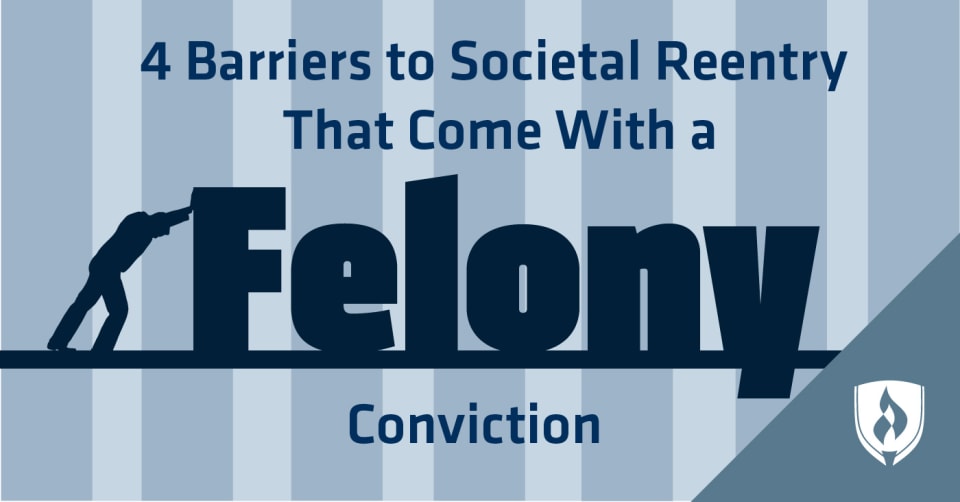Life After Prison: 4 Barriers to Societal Reentry that Come with a Felony Conviction
By Will Erstad on 04/17/2018

For many people, not much thought is given to a convict after the guilty verdict is reached in the courtroom. Justice was served—a person who broke the law is now removed from the community and the rest of us can move on, right? That’s likely shortsighted.
It’s easy to mentally write off a convicted felon. But according to a study from the U.S. Department of Justice (DOJ), the average felony sentence was just over three years.* That means most of these convicts typically have a lot of time for life after prison.
If the goal is to reform these individuals and welcome them back as productive members of society, the numbers don’t look good. A separate DOJ study found that an eye-popping 76 percent of the thousands of inmates studied were arrested again within five years of their release.
So why is this happening? Unless you’re a subscriber to the idea that people are just “born bad,” there’s got to be a different reason for such a high arrest rate.
While the likely answer to that is found in a complex mix of personal, economic and societal factors, there are some clear barriers that make reintegration challenging for those with a felony conviction. In this article, we’ll take a closer look at some of these barriers and what, if anything, is being done to help.
Wondering what life is truly like behind bars? Dive into What is Jail Really Like? to gain insights into the realities of incarceration.
What is a felony, exactly?
As you probably already know, not all crimes are treated as equally severe—you don’t get sent to prison for jaywalking. A felony is a class of criminal offense that is reserved for the most serious crimes. Many felony crimes are violent in nature—like armed robbery, murder and sexual assault. But many others are property or drug-related.
There’s no denying that a felony conviction is a serious offense that comes with a serious punishment—but often the effects of this punishment linger for the rest of their lives, no matter the changes or choices they’ve made since.
4 Issues felons face during life after prison
1. Employment
Lack of employment opportunities for former felons is easily one of the biggest factors in recidivism. Employers are understandably skittish about hiring felons, and that can make life extremely difficult for any ex-con trying to make a fresh start. If a felon can’t find work—let alone work that pays a decent wage—turning toward illegal ways to make money becomes much more palatable and the cycle continues.
Hiring felons can be a tricky subject for employers. Some argue employers can be sued and held liable for negligent hiring practices if they don’t do their due diligence in examining employee backgrounds. On the other hand, using applicant criminal history information can also leave employers vulnerable to legal action if their policies result in discrimination. Additionally, many felons aren’t applying for positions with a limited number of applicants, so it can be easy for employers to err on the side of caution and hire an equally qualified, non-felon candidate.
What’s being done to help? In recent years, reformers have pushed to “ban the box,” which hopes to remove questions regarding criminal records from employment applications and delay background checks until later in the hiring process. The idea is to prevent employers from screening out people with criminal records without at giving them a fair chance to be compared to other applicants.
The federal government also offers tax incentives to employers who hire people from groups facing significant barriers to employment. Additionally, a tighter job market has helped as employers become less choosy in their hiring decisions.
2. Housing issues
Another difficult task felons face in their life after prison is finding a place to live. Many landlords refuse to rent to former convicts as they are not a protected class of citizens. This means felons are often stuck trying to find temporary housing with friends and family members—some of whom may be part of the bad influences that helped land them in prison in the first place.
Lack of stable housing compounds the issues felons face in finding work as it is. Studies show that a lack of housing options sustains a negative cycle of increased homelessness, which also leads to more incarceration.
What is being done to help? In the spring of 2016, the Department of Housing and Urban Development (HUD) proposed a guideline change that would leave landlords open to civil suits if it can be proven their refusal to rent to those with criminal records disproportionately harms protected minority groups under the Fair Housing Act. Additionally, many states have nonprofit “halfway homes,” or reentry programs, that work to give former inmates a stable environment as they get resettled. While the idea of a supervised living situation might not sound ideal for someone leaving prison, it is often better than the alternative.
3. Education
Many felons are way behind the educational curve. One survey of 1,300 inmates found that approximately 30 percent of convicted felons did not have a high school diploma or GED, which dwarfs the 14 percent of all U.S. adults with no diploma or GED. In an economic environment where more employers are seeking candidates with a college education, that achievement gap can be disastrous.
Further complicating things is that funding for prison education programs is spotty and inconsistent from state to state, which can limit opportunities for the incarcerated to catch up. Additionally, inmates are no longer eligible for Pell grants, and certain drug convictions may impact eligibility for financial aid, depending on the circumstances.
What is being done to help? There has not been a lot of progress at a federal level in congress—some tenets of criminal justice reform see bipartisan support, but no breakthrough has been made for prisoner education. That said, some states are making moves to provide additional educational funding for incarcerated individuals.
4. Voter disenfranchisement
Another often overlooked disadvantage of life after prison is not having the right to vote. While this isn’t quite as severe as not having a house or a job, voting is still an important part of being an engaged citizen. Currently, 35 states prevent persons on parole from voting—and 12 other states have laws that either permanently ban felons from voting or require significant waiting periods before being eligible to vote again.
Four states (Florida, Iowa, Virginia and Kentucky) place a ban on voting for felons where the right to vote is only restored after a state officer or board signs off. Other states have voter reinstatement processes that critics call arduous and discouraging. That means millions of people who’ve served their time are prevented from weighing in on the direction of their government.
What is being done to help? Changes to the voting rights of former felons are generally going to come from state governments. Reform groups like FairVote and the American Civil Liberties Union (ACLU) work to lobby state legislatures and present legal challenges to these rules. Additionally, in November 2018, Florida voters will have a chance to weigh in on initiated constitutional amendment that would automatically restore voting rights for most felons who’ve completed their sentence, parole or probationary period.
Why should you care about a felon’s life after prison?
A convicted felon has made poor decisions in life—so why should we care what happens to them? As mentioned before, the time they spend incarcerated is typically only a small portion of their lives. The barriers described above all contribute to the high likelihood of felons falling back into a cycle of criminal behavior and incarceration, which has negative side effects that seep into our communities.
Additionally, there are fiscal benefits to felons successfully reentering society. In 2015, the Federal Bureau of Prisons found the average yearly cost of federal imprisonment was just under $32,000 per inmate—and federal inmates are only a small portion of the overall prison population. While additional educational and vocational training would require funding, a 2013 RAND Corporation study found that for every dollar invested in prison education, incarceration costs dropped four to five dollars during the first three years post-release. This is a result of decreased recidivism and improved employment opportunities.
How can you help former convicts get back on track?
Life after prison doesn’t have to be a life sentenced to failure. If learning more about these barriers to reentry former convicts face has you thinking you want to get involved, that’s great! Better yet, there are entire career paths that focus on helping the convicted get back on track.
Human services professionals often work closely with nonprofits and government agencies to help former offenders get established. If you’re interested in this type of work, learn more about what it takes in our article, “8 Signs You Were Meant to Work in the Human Services Field.”
Probation and parole officers are also on the front lines of reforming the lives of individuals within the criminal justice system. If you’d like to learn more about the differences between these two roles and how they’d fit your career ambitions, then read our article, “Parole Officer vs. Probation Officer: Which One Is Right For You?”
*U.S. Department of Justice, Bureau of Justice Statistics, Felony Sentences in State Courts, 2006 - [Information accessed April 11, 2018] https://www.bjs.gov/content/pub/pdf/fssc06st.pdf
Related Articles:




